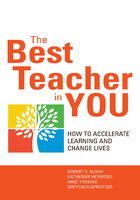
Summary
Highly effective teachers like Kelli have daunting challenges. They work with the same students in the same schools with the same resources as other teachers. Their organizational context is hierarchical, conflictridden, and politically charged. And while these challenges lead some teachers to feel frustrated, discouraged, and dissatisfied, highly effective teachers somehow learn to perform at high levels.
Through our work with HETs, we have tried to make sense of what accounts for their extraordinary impact. To do this we have drawn from a number of different scientific literatures to develop some hypotheses about the integration of the directive and co-creative perspectives. This book shares our theories with you. Chapter 2 introduces a framework that will help you more deeply examine and reflect on HETs’ journeys from novice to master teacher so that you can begin to apply these lessons to your own teaching practice.
 PLANTING SEEDS
PLANTING SEEDS
1. Kelli says, “It is not about teaching math. It is about getting them to want to learn.” What are the implications of working toward the one purpose versus the other? How might the two purposes be integrated?
2. Kelli started out well, but her students changed and her assumptions did not. This led to failure and frustration. Her friends advised her, “You have to realize early on that you are not the key to every door.” When have you received or given such advice? What arguments justify this advice? How is accepting such advice conspiring in your own diminishment?
3. Kelli made a vow that took her on a new path. She states:
I needed to pay more attention to those types of kids. I had to figure out what works for them, how to have respect for them, how to use humor to diffuse explosive situations. I learned how to make those kinds of kids feel safe in my room, and I learned how to teach them social skills so the other students would feel safe in the room with such a child. And then I learned that I have to be very parent-savvy. I have to sit down and get the parents on my side very early on. So I learned those techniques, and I’ve never had another year like that.
How is this kind of learning different from the procedural learning to which we are more accustomed? What are the key requirements for this kind of learning? What does this suggest about your most pressing frustrations?
 GROWING YOUR PRACTICE
GROWING YOUR PRACTICE
1. What is one specific practice you can undertake in your next week of teaching to build momentum on the journey to the co-creative perspective? Use the right-hand column in figure 1.1 to help you identify a specific practice. Be specific about when, who, what, and how you will get started.
2. Following Kelli’s advice, identify one student whom you would like to reach in a deeper way. Find out what he or she is interested in and use that interest to build a relationship. If it is not something you know about, approach the child as if you are the learner and you want the child to teach you about his or her passion.